Using Airborne Geophysical and Geochemical Methods to Map Structures and Their Related Gold Mineralization
Abstract
:1. Introduction
2. Geological Outlines
2.1. Location and Topography
2.2. Structure and Geological Setting
2.3. Mineralization
3. Materials and Methods
3.1. Processing and Interpretation of Airborne Magnetic Data
3.1.1. Regional–Residual Separation
3.1.2. First-Order Vertical Derivative (FVD) Method
3.1.3. Total Horizontal Gradient (THG) Method
3.1.4. Tilted Derivative (TD) Method
3.1.5. Analytical Signal (AS) Technique
3.1.6. Tilt Angle (TA) and Theta Filters
3.1.7. CET Grid Analysis
3.1.8. CET Porphyry Analysis
3.2. Geochemical and Analytical Methods
4. Results and Discussion
4.1. Airborne Magnetic Data
4.2. Geochemical Sampling Surveys
4.2.1. Petrography and Mineral Chemistry of Silicates in the Host-Rock and Ore Samples
4.2.2. Geothermobarometry and the Tectono-Magmatic Setting
4.2.3. Distributions of Source and Ore Deposits
5. Conclusions
Supplementary Materials
Author Contributions
Funding
Data Availability Statement
Acknowledgments
Conflicts of Interest
References
- El Ramly, M.F. The occurrence of gold in the Eastern Desert of Egypt. Stud. Some Miner. Depos. Egypt. Geol. Surv. Egypt. 1970, 53–64. [Google Scholar]
- Botros, N.S. A new classification of the gold deposits of Egypt. Ore Geol. Rev. 2004, 25, 1–37. [Google Scholar] [CrossRef]
- Abu-Alam, T.; Grosch, E.; Abd El Monsef, M. Pan-African shear zone-hosted gold mineralization in the Arabian-Nubian shield. EGU Gen. Assem. Conf. Abstr. 2013, EGU2013-9893. [Google Scholar]
- Eldosouky, A.M.; El-Qassas, R.A.; Pour, A.B.; Mohamed, H.; Sekandari, M. Integration of ASTER satellite imagery and 3D inversion of aeromagnetic data for deep mineral exploration. Adv. Space Res. 2021, 68, 3641–3662. [Google Scholar] [CrossRef]
- Eldosouky, A.M.; El-Qassas, R.A.Y.; Pham, L.T.; Abdelrahman, K.; Alhumimidi, M.S.; El Bahrawy, A.; Mickus, K.; Sehsah, H. Mapping Main Structures and Related Mineralization of the Arabian Shield (Saudi Arabia) Using Sharp Edge Detector of Transformed Gravity Data. Minerals 2022, 12, 71. [Google Scholar] [CrossRef]
- Amer, O.; Kharbish, S.; Maged, A.; Khedr, F. Geochemical insight into granite hosted U-rich fluorite, Gabal El-Erediya area, Central Eastern Desert, Egypt: REE geochemical and fluid inclusion aspects. Arab. J. Geosci. 2021, 14, 1232. [Google Scholar] [CrossRef]
- Elwan, W.; Azzaz, S.; Balasi, M.; Amer, O. Petrogenesis of Maktali fractionated calc-alkaline younger granitoids, Central Eastern Desert, Egypt. Arab. J. Geosci. 2019, 12, 393. [Google Scholar] [CrossRef]
- Mohamed, A.; Abdelrady, M.; Alshehri, F.; Mohammed, M.; Abdelrady, A. Detection of Mineralization Zones Using Aeromagnetic Data. Appl. Sci. 2022, 12, 9078. [Google Scholar] [CrossRef]
- Kharbish, S.; Eldosouky, A.; Amer, O. Integrating mineralogy, geochemistry and aeromagnetic data for detecting Fe–Ti ore deposits bearing layered mafic intrusion, Akab El-Negum, Eastern Desert, Egypt. Sci. Rep. 2022, 12, 15474. [Google Scholar] [CrossRef]
- Pham, L.T.; Eldosouky, A.M.; Abdelrahman, K.; Fnais, M.S.; Gomez-Ortiz, D.; Khedr, F. Application of the improved parabola-based method in delineating lineaments of subsurface structures: A case study. J. King Saud Univ.-Sci. 2012, 33, 101585. [Google Scholar] [CrossRef]
- Dufréchou, G.; Harris, L.B.; Corriveau, L.; Antonoff, V. Regional and local controls on mineralization and pluton emplacement in the Bondy gneiss complex, Grenville Province, Canada interpreted from aeromagnetic and gravity data. J. Appl. Geophys. 2015, 116, 192–205. [Google Scholar] [CrossRef]
- Bencharef, M.H.; Eldosouky, A.; Zamzam, S.; Boubaya, D. Polymetallic mineralization prospectivity modelling using multi-geospatial data in logistic regression: The Diapiric Zone, Northeastern Algeria. Geocarto Int. 2022, 1–36. [Google Scholar] [CrossRef]
- An, S.; Zhou, K.; Wang, J.; Zhang, N.; Liao, S.; Feng, Q.; Zhang, Z. Interpretation of high resolution aeromagnetic data for structures study and exploration of polymetallic deposits in Kalatage area, eastern Tianshan (NW China). Geosci. J. 2020, 24, 315–327. [Google Scholar] [CrossRef]
- El-Desoky, H.M.; Shebl, A.; Abdel-Rahman, A.M.; Fahmy, W.; El-Awny, H.; El-Sherif, A.M.; El-Rahmany, M.M.; Csámer, Á. Multiscale mineralogical investigations for mineral potentiality mapping of Ras El-Kharit-Wadi Khashir district, Southern Eastern Desert, Egypt. Egypt. J. Remote Sens. Space Sci. 2022, 4, 941–960. [Google Scholar] [CrossRef]
- Shebl, A.; Abdellatif, M.; Elkhateeb, S.O.; Csámer, Á. Multisource data analysis for gold potentiality mapping of Atalla area and its environs, Central Eastern Desert, Egypt. Minerals 2021, 11, 641. [Google Scholar] [CrossRef]
- Shebl, A.; Abdellatif, M.; Hissen, M.; Abdelaziz, M.I.; Csámer, Á. Lithological mapping enhancement by integrating Sentinel 2 and gamma-ray data utilizing support vector machine: A case study from Egypt. Int. J. Appl. Earth Obs. Geoinf. 2021, 105, 102619. [Google Scholar] [CrossRef]
- Prasad, K.N.D.; Pham, L.T.; Singh, A.P.; Eldosouky, A.M.; Abdelrahman, K.; Fnais, M.S.; Gómez-Ortiz, D. A Novel Enhanced Total Gradient (ETG) for Interpretation of Magnetic Data. Minerals 2022, 12, 1468. [Google Scholar] [CrossRef]
- Eldosouky, A.M.; Abdelkareem, M.; Elkhateeb, S.O. Integration of remote sensing and aeromagnetic data for mapping structural features and hydrothermal alteration zones in Wadi Allaqi area, South Eastern Desert of Egypt. J. Afr. Earth Sci. 2017, 130, 28–37. [Google Scholar] [CrossRef]
- Hang, N.T.T. Application of directional derivative method to determine boundary of magnetic sources by total magnetic anomalies. Vietnam J. Earth Sci. 2017, 39, 360–375. [Google Scholar] [CrossRef]
- Thanh, L.P. Determination of subsurface lineaments in the Hoang Sa islands using enhanced methods of gravity total horizontal gradient. Vietnam J. Earth Sci. 2022, 44, 395–409. [Google Scholar]
- Eldosouky, A.M.; Pham, L.; Abdelrahman, K.; Fnais, M.; Gomez-Ortiz, D. Mapping structural features of the Wadi Umm Dulfah area using aeromagnetic data. J. King Saud Univ.-Sci. 2022, 34, 101803. [Google Scholar] [CrossRef]
- Eldosouky, A.M.; Pham, L.; Mohmed, H.; Pradhan, B. A comparative study of THG, AS, TA, Theta, TDX and LTHG techniques for improving source boundaries detection of magnetic data using synthetic models: A case study from G. Um Monqul, North Eastern Desert, Egypt. J. Afr. Earth Sci. 2020, 170, 103940. [Google Scholar] [CrossRef]
- Cordell, L.; Grauch, V.J.S. Mapping basement magnetization zones from aeromagnetic data in the San Juan Basin, New Mexico. In The Utility of Regional Gravity and Magnetic Anomaly Maps; Society of Exploration Geophysicists: Tulsa, OK, USA, 1985; pp. 181–197. [Google Scholar]
- Miller, H.G.; Singh, V. Potential field tilt—A new concept for location of potential field sources. J. Appl. Geophys. 1994, 32, 213–217. [Google Scholar] [CrossRef]
- Wijns, C.; Perez, C.; Kowalczyk, P. Theta map: Edge detection in magnetic data. Geophysics 2005, 70, L39–L43. [Google Scholar] [CrossRef]
- Macnae, J. Applications of geophysics for the detection and exploration of kimberlites and lamproites. J. Geochem. Explor. 1995, 53, 213–243. [Google Scholar] [CrossRef]
- Holden, E.-J.; Dentith, M.; Kovesi, P. Towards the automated analysis of regional aeromagnetic data to identify regions prospective for gold deposits. Comput. Geosci. 2008, 34, 1505–1513. [Google Scholar] [CrossRef]
- Core, D.; Buckingham, A.; Belfield, S. Detailed structural analysis of magnetic data—Done quickly and objectively. SGEG Newsl. 2009, 1–2. [Google Scholar]
- Barnes, S.J.; Roeder, P.L. The range of spinel compositions in terrestrial mafic and ultramafic rocks. J. Petrol. 2001, 42, 2279–2302. [Google Scholar] [CrossRef]
- Conoco, C. Geological map of Egypt, scale 1: 500,000-NF 36 NE-Bernice, Egypt. Egypt. Gen. Pet. Corp. Cairo 1987. [Google Scholar]
- Stern, R.J. The Najd fault system, Saudi Arabia and Egypt: A late Precambrian rift-related transform system? Tectonics 1985, 4, 497–511. [Google Scholar] [CrossRef]
- Habib, M.E. Arc ophiolites in the Pan-African basement between Meatiq and Abu Furad, Eastern Desert, Egypt. Bull. Fac. Sci. Assiut Univ. C Biol. Geol. 1987, 16, 241–283. [Google Scholar]
- Gass, I.G. The evolution of the Pan African crystalline basement in NE Africa and Arabia. J. Geol. Soc. 1977, 134, 129–138. [Google Scholar] [CrossRef]
- Shukri, N.M.; MANSOUR, M.S. Lithostratigraphy of Um Samuiki District, Eastern Desert, Egypt. In Evolution and Mineralization of the Arabian–Nubian Shield; King Abdulaziz University: Jeddah, Saudi Arabia, 1980. [Google Scholar]
- Hafez, A.; Shalaby, L.M. On the geochemical characteristics of the volcanic rocks at Umm Samiuki, Eastern Desert, Egypt. Egypt. J. Geol. 1983, 27, 73–92. [Google Scholar]
- Khudeir, A.A.; Ali, M.; El Habaak, G.H. The metavolcanics at Um Samiuki area, Egypt. Bull. Fac. Sci. Assiut Univ. 1988, 17, 73–101. [Google Scholar]
- Stern, R.J.; Kröner, A.; Rashwan, A.A. A late Precambrian (∼710 Ma) high volcanicity rift in the southern Eastern Desert of Egypt. Geol. Rundsch. 1991, 80, 155–170. [Google Scholar] [CrossRef]
- Abdel-Karim, A.-A.M.; Ali, S.; El-Awady, A.; Elwan, W.; Khedr, M.Z.; Tamura, A. Mineral and bulk–rock chemistry of Shadli bimodal metavolcanics from Eastern Desert of Egypt: Implication for tectonomagmatic setting and Neoproterozoic continental growth in the Arabian–Nubian Shield. Lithos 2019, 338, 204–217. [Google Scholar] [CrossRef]
- Resources, A. Aton Drills Further High Grade Gold-Polymetallic Sulphide Mineralisation at Rodruin, Returning 7.04 g/t Gold, 47.2 g/t Silver, 0.63% Copper and 7.18% Zinc over 36.9 Metres. Aton Company, Egypt, Mining, June 2022. Available online: https://atonresources.com/news/2022/aton-drills-further-wide-zones-of-oxide-mineralisation-at-rodruin-returning-1.72-g-t-gold-and-11.5-g-t-silver-over-75.2m-from/ (accessed on 13 June 2022).
- Shanks, W.P., III.; Koski, R.A.; Mosier, D.L.; Schulz, K.J.; Morgan, L.A.; Slack, J.F.; Ridley, W.I.; Dusel-Bacon, C.; Seal, R.R.; Piatak, N.M. Volcanogenic Massive Sulfide Occurrence Model: Chapter C in Mineral Deposit Models for Resource Assessment; U.S. Geological Survey: Baltimore, MD, USA, 2012. [Google Scholar]
- Aeroservice. Final Report on Airborne Magnetic/Radiation Survey in Eastern Desert, Egypt. Work Completed for the Egyptian General Petroleum Corporation (EGPC); Aero Service: Houston, TX, USA, 1984; Volume 6. [Google Scholar]
- Oasis Montaj Program, version. 8.4. Geosoft Mapping and Processing System. Geosoft Inc: Toronto, ON, Canada, 2015.
- Aitken, A.R.; Betts, P.G. Multi-scale integrated structural and aeromagnetic analysis to guide tectonic models: An example from the eastern Musgrave Province, Central Australia. Tectonophysics 2009, 476, 418–435. [Google Scholar] [CrossRef]
- Baratoux, L.; Metelka, V.; Naba, S.; Ouiya, P.; Siebenaller, L.; Jessell, M.; Naré, A.; Salvi, S.; Béziat, D.; Franceschi, G. Tectonic evolution of the Gaoua region, Burkina Faso: Implications for mineralization. J. Afr. Earth Sci. 2015, 112, 419–439. [Google Scholar] [CrossRef]
- Metelka, V.; Baratoux, L.; Naba, S.; Jessell, M.W. A geophysically constrained litho-structural analysis of the Eburnean greenstone belts and associated granitoid domains, Burkina Faso, West Africa. Precambrian Res. 2011, 190, 48–69. [Google Scholar] [CrossRef]
- Blakely, R.J.; Simpson, R.W. Approximating edges of source bodies from magnetic or gravity anomalies. Geophysics 1986, 51, 1494–1498. [Google Scholar] [CrossRef]
- Milligan, P.R.; Gunn, P.J. Enhancement and presentation of airborne geophysical data. AGSO J. Aust. Geol. Geophys. 1997, 17, 63–75. [Google Scholar]
- Pilkington, M.; Keating, P.B. The utility of potential field enhancements for remote predictive mapping. Can. J. Remote Sens. 2009, 35 (Suppl. S1), S1–S11. [Google Scholar] [CrossRef]
- Verduzco, B.; Fairhead, J.; Green, C.; MacKenzie, C. New insights into magnetic derivatives for structural mapping. Lead. Edge 2004, 23, 116. [Google Scholar] [CrossRef]
- El-Ata, A.S.A.; EI-Khafeef, A.A.; Ghoneimi, A.E.; Alnabi, S.H.A.; Al-Badani, M.A. Applications of aeromagnetic data to detect the Basement Tectonics of Eastern Yemen region. Egypt. J. Pet. 2013, 22, 277–292. [Google Scholar] [CrossRef]
- Keating, P. A simple technique to identify magnetic anomalies due to kimberlite pipes. Explor. Min. Geol. 1995, 4, 121–125. [Google Scholar]
- Grauch, V.J.S.; Cordell, L. Limitations of determining density or magnetic boundaries from the horizontal gradient of gravity or pseudogravity data. Geophysics 1987, 52, 118–121. [Google Scholar] [CrossRef]
- Phillips, J.D. Locating magnetic contacts: A comparison of the horizontal gradient, analytic signal, and local wavenumber methods. In SEG Technical Program Expanded Abstracts 2000; Society of Exploration Geophysicists: Tulsa, OK, USA, 2000; pp. 402–405. [Google Scholar]
- Nabighian, M.N. The analytic signal of two-dimensional magnetic bodies with polygonal cross-section: Its properties and use for automated anomaly interpretation. Geophysics 1972, 37, 507–517. [Google Scholar] [CrossRef]
- Roest, W.R.; Pilkington, M. Identifying remanent magnetization effects in magnetic data. Geophysics 1993, 58, 653–659. [Google Scholar] [CrossRef]
- Ansari, A.H.; Alamdar, K. Reduction to the pole of magnetic anomalies using analytic signal. World Appl. Sci. J. 2009, 7, 405–409. [Google Scholar]
- Roest, W.R.; Verhoef, J.; Pilkington, M. Magnetic interpretation using the 3-D analytic signal. Geophysics 1992, 57, 116–125. [Google Scholar] [CrossRef]
- Eldosouky, A.M. Aeromagnetic data for mapping geologic contacts at Samr El-Qaa area, north Eastern Desert, Egypt. Arab. J. Geosci. 2019, 12, 1–13. [Google Scholar] [CrossRef]
- Telford, W.M.; Geldart, L.P.; Sheriff, R.E.; Keys, D.A. Applied Geophysics; Cambridge University Press: Cambridge, UK; New York Press: New York, NY, USA, 1976; pp. 1–860. [Google Scholar]
- Klitzsch, E. Plate tectonics and cratonal geology in Northeast Africa (Egypt, Sudan). Geol. Rundsch. 1986, 75, 755–768. [Google Scholar] [CrossRef]
- Schandelmeier, H.; Richter, A.; Harms, U. Proterozoic deformation of the East Saharan Craton in southeast Libya, south Egypt and north Sudan. Tectonophysics 1987, 140, 233–246. [Google Scholar] [CrossRef]
- Grauch, V.J.S.; Johnston, C.S. Gradient window method: A simple way to separate regional from local horizontal gradients in gridded potential-field data. In Proceedings of the 2002 SEG Annual Meeting, Salt Lake City, UT, USA, 8–9 October 2002. [Google Scholar]
- Grauch, V.J.S.; Hudson, M.R. Guides to understanding the aeromagnetic expression of faults in sedimentary basins: Lessons learned from the central Rio Grande rift, New Mexico. Geosphere 2007, 3, 596. [Google Scholar] [CrossRef]
- Elkhateeb, S.O.; Abdellatif, M.A.G. Delineation potential gold mineralization zones in a part of Central Eastern Desert, Egypt using Airborne Magnetic and Radiometric data. NRIAG J. Astron. Geophys. 2018, 7, 361–376. [Google Scholar] [CrossRef]
- Abdel-Khalek, M.X. Tectonic evolution of the basement rocks in the southern and central Eastern Desert of Egypt. Evol. Miner. Arab.-Nubian Shield 2017, 1, 53–62. [Google Scholar]
- Morimoto, N. Nomenclature of pyroxenes. Mineral. Petrol. 1988, 68, 95–111. [Google Scholar]
- Le Bas, M.J. The role of aluminum in igneous clinopyroxenes with relation to their parentage. Am. J. Sci. 1962, 260, 267–288. [Google Scholar] [CrossRef]
- Delavari, M.; Amini, S.; Saccani, E.; Beccaluva, L. Geochemistry and petrogenesis of mantle peridotites from the Nehbandan Ophiolitic Complex, Eastern Iran. J. Appl. Sci. 2009, 9, 2671–2687. [Google Scholar] [CrossRef]
- Wright, J.; Lentz, D.; Rossiter, S.; Garland, P. Analysis of Au-Ag Mineralization in the Caribou Base-Metal VMS Deposit, New Brunswick; Examination of Micro-Scale Inter-and Intra-Sulphide Distribution and Its Relation to Geometallurgy. Minerals 2016, 6, 113. [Google Scholar] [CrossRef]
- Xuexin, S. Minor elements and ore genesis of the Fankou lead-zinc deposit, China. Miner. Deposita 1984, 19, 95–104. [Google Scholar] [CrossRef]
- Chen, P.; Fang, N.; Yuan, X. Geochemical insights from clinopyroxene phenocrysts into the magma evolution of an alkaline magmatic system from the Sanshui Basin, South China. Minerals 2021, 11, 1295. [Google Scholar] [CrossRef]
- Soesoo, A. A multivariate statistical analysis of clinopyroxene composition: Empirical coordinates for the crystallisation PT-estimations. GFF 1997, 119, 55–60. [Google Scholar] [CrossRef]
- Green, D.H.; Ringwood, A.E. The Genesis of Basaltic Magmas: Contributions in Mineralogy and Petrology. Contrib. Mineral. Petrol. 1967, 15, 103–190. [Google Scholar] [CrossRef]
- Lindsley, D.H. Pyroxene thermometry. Am. Mineral. 1983, 68, 477–493. [Google Scholar]
- DeBari, S.M.; Coleman, R.G. Examination of the deep levels of an island arc: Evidence from the Tonsina ultramafic-mafic assemblage, Tonsina, Alaska. J. Geophys. Res. Solid Earth 1989, 94, 4373–4391. [Google Scholar] [CrossRef]
- Leterrier, J.; Maury, R.; Thonon, P.; Girard, D.; Marchal, M. Clinopyroxene composition as a method of identification of the magmatic affinities of paleo-volcanic series. Earth Planet. Sci. Lett. 1982, 59, 139–154. [Google Scholar] [CrossRef]
- Nisbet, E.G.; Pearce, J.A. Clinopyroxene composition in mafic lavas from different tectonic settings. Contrib. Mineral. Petrol. 1977, 63, 149–160. [Google Scholar] [CrossRef]
- Beccaluva, L.; Macciotta, G.; Piccardo, G.; Zeda, O. Clinopyroxene composition of ophiolite basalts as petrogenetic indicator. Chem. Geol. 1989, 77, 165–182. [Google Scholar] [CrossRef]
- Loucks, R.R. Discrimination of ophiolitic from nonophiolitic ultramafic-mafic allochthons in orogenic belts by the Al/Ti ratio in clinopyroxene. Geology 1990, 18, 346–349. [Google Scholar] [CrossRef]
- Ohmoto, H. Formation of volcanogenic massive sulfide deposits: The Kuroko perspective. Ore Geol. Rev. 1996, 10, 135–177. [Google Scholar] [CrossRef]
- El-Rahman, A.; Surour, A.A.; El-Manawi, A.H.W.; El-Dougdoug, A.-M.A.; Omar, S. Regional setting and characteristics of the Neoproterozoic Wadi Hamama Zn–Cu–Ag–Au prospect: Evidence for an intra-oceanic island arc-hosted volcanogenic hydrothermal system. Int. J. Earth Sci. 2015, 104, 625–644. [Google Scholar] [CrossRef]
- Franklin, J.M.; Lydon, J.W.; Sangster, D.F. Volcanic-Associated Massive Sulfide Deposits; Economic Geology Publishing: Littleton, CO, USA, 1981. [Google Scholar]
- Hannington, M.D.; Poulsen, K.H.; Thompson, J.F.H.; Sillitoe, R.H. Volcanogenic Gold in the Massive Sulfide Environment; Society of Economic Geologists: Littleton, CO, USA, 1997. [Google Scholar]
- Hannington, M.D.; De Ronde, C.E.; Petersen, S. Sea-Floor Tectonics and Submarine Hydrothermal Systems; Society of Economic Geologists: Littleton, CO, USA, 2005. [Google Scholar]
- Piercey, S.J. The setting, style, and role of magmatism in the formation of volcanogenic massive sulfide deposits. Miner. Deposita 2011, 46, 449–471. [Google Scholar] [CrossRef]
- Gottesmann, W.; Kampe, A. Zn/Cd ratios in calcsilicate-hosted sphalerite ores at Tumurtijn-ovoo, Mongolia. Geochemistry 2007, 67, 323–328. [Google Scholar] [CrossRef]
- Peter, J.M. Ancient iron formations: Their genesis and use in the exploration for stratiform base metal sulphide deposits, with examples from the Bathurst Mining Camp. GeoText 2003, 4, 145–176. [Google Scholar]
- Spry, P.G.; Peter, J.M.; Slack, J.F. Meta-exhalites as exploration guides to ore. Rev. Econ. Geol. 2000, 11, 163–201. [Google Scholar]
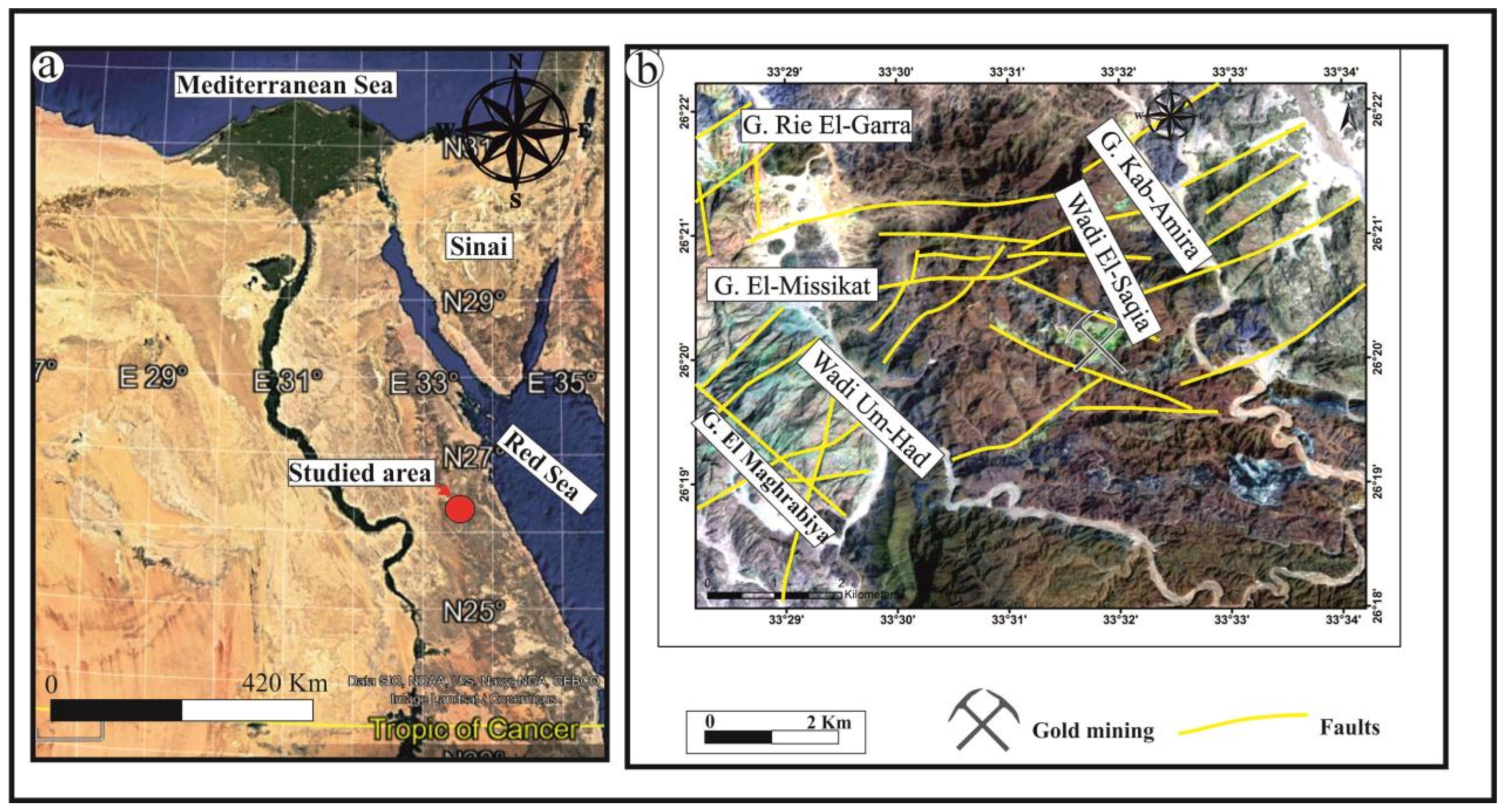
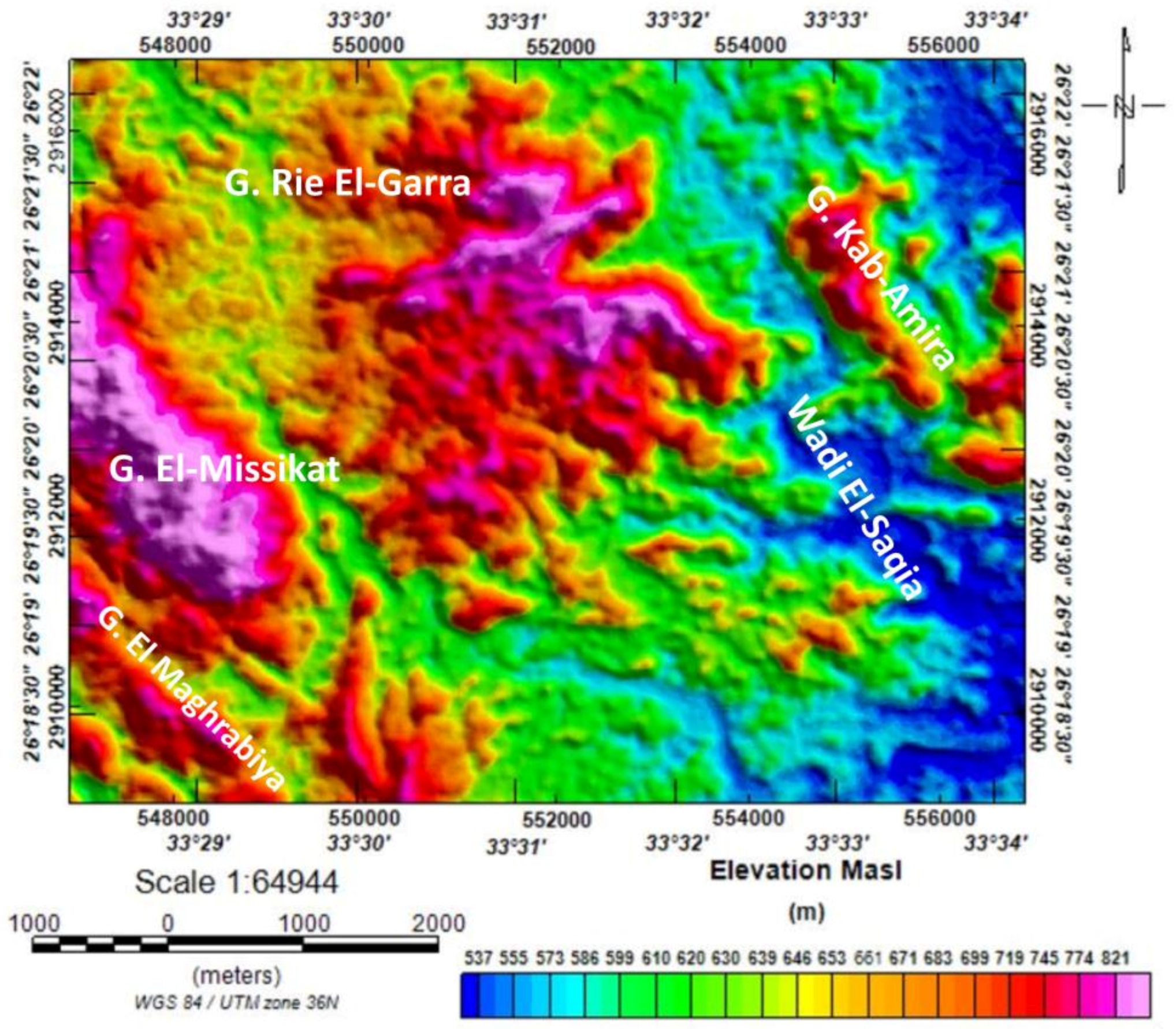
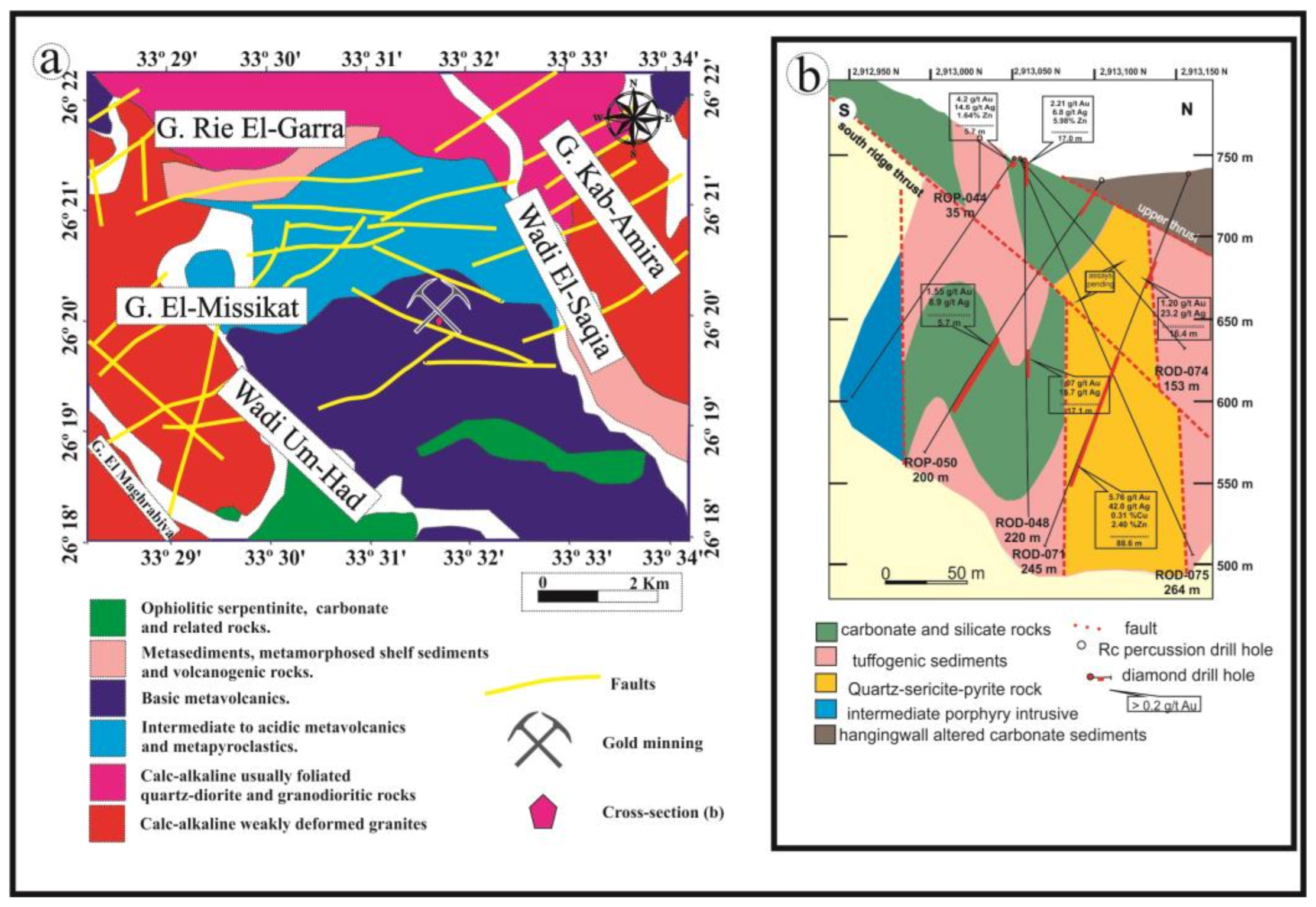
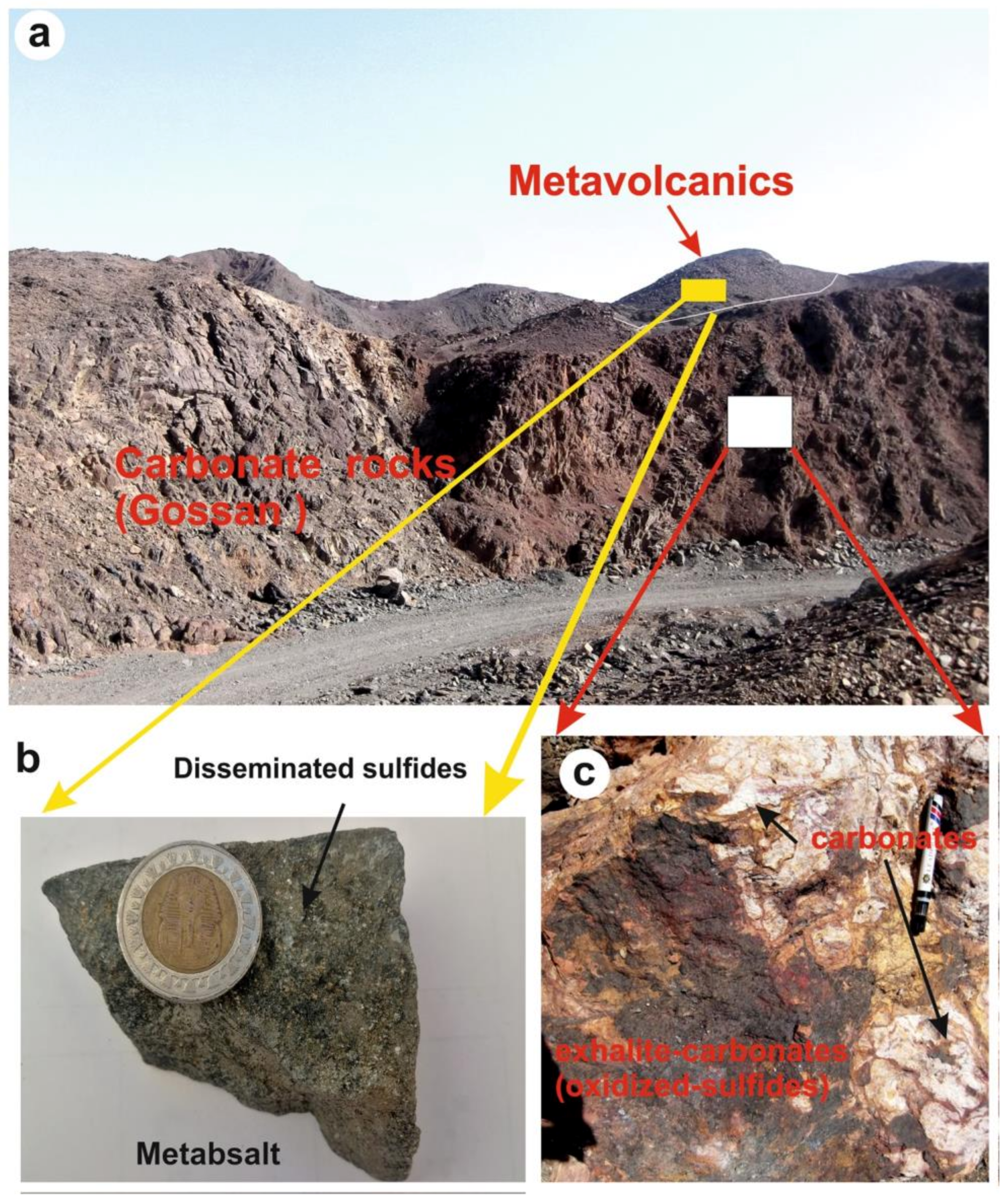
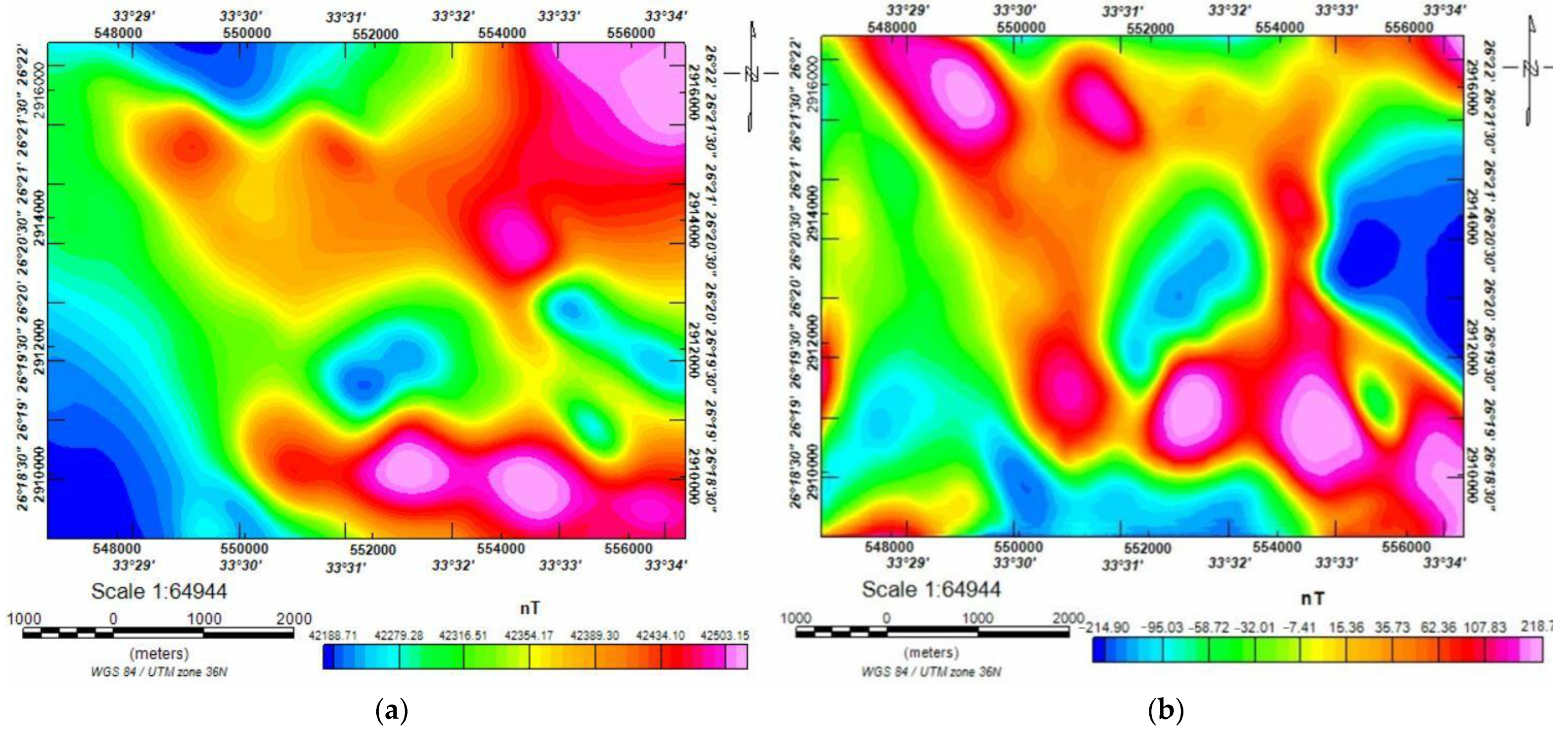
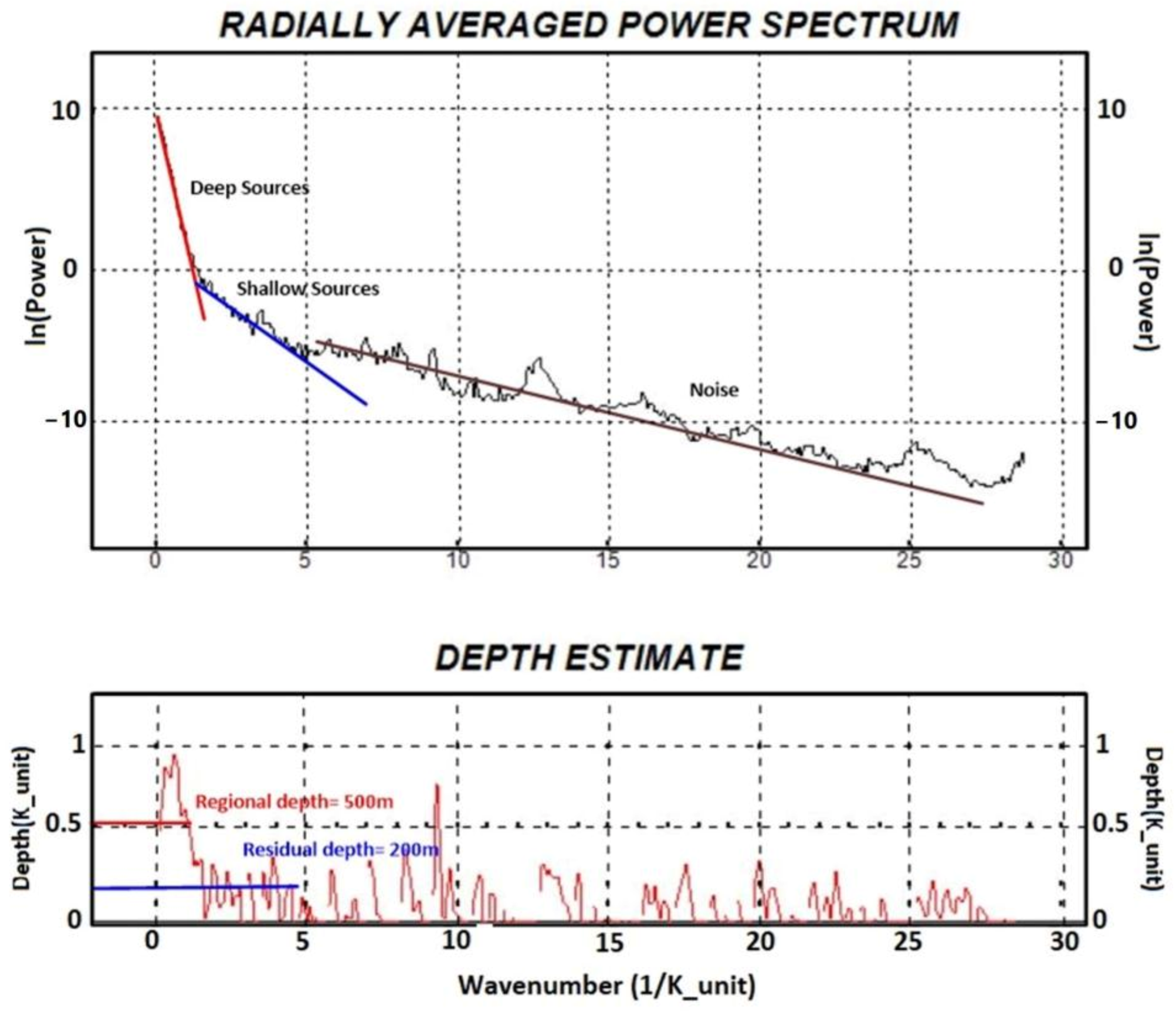
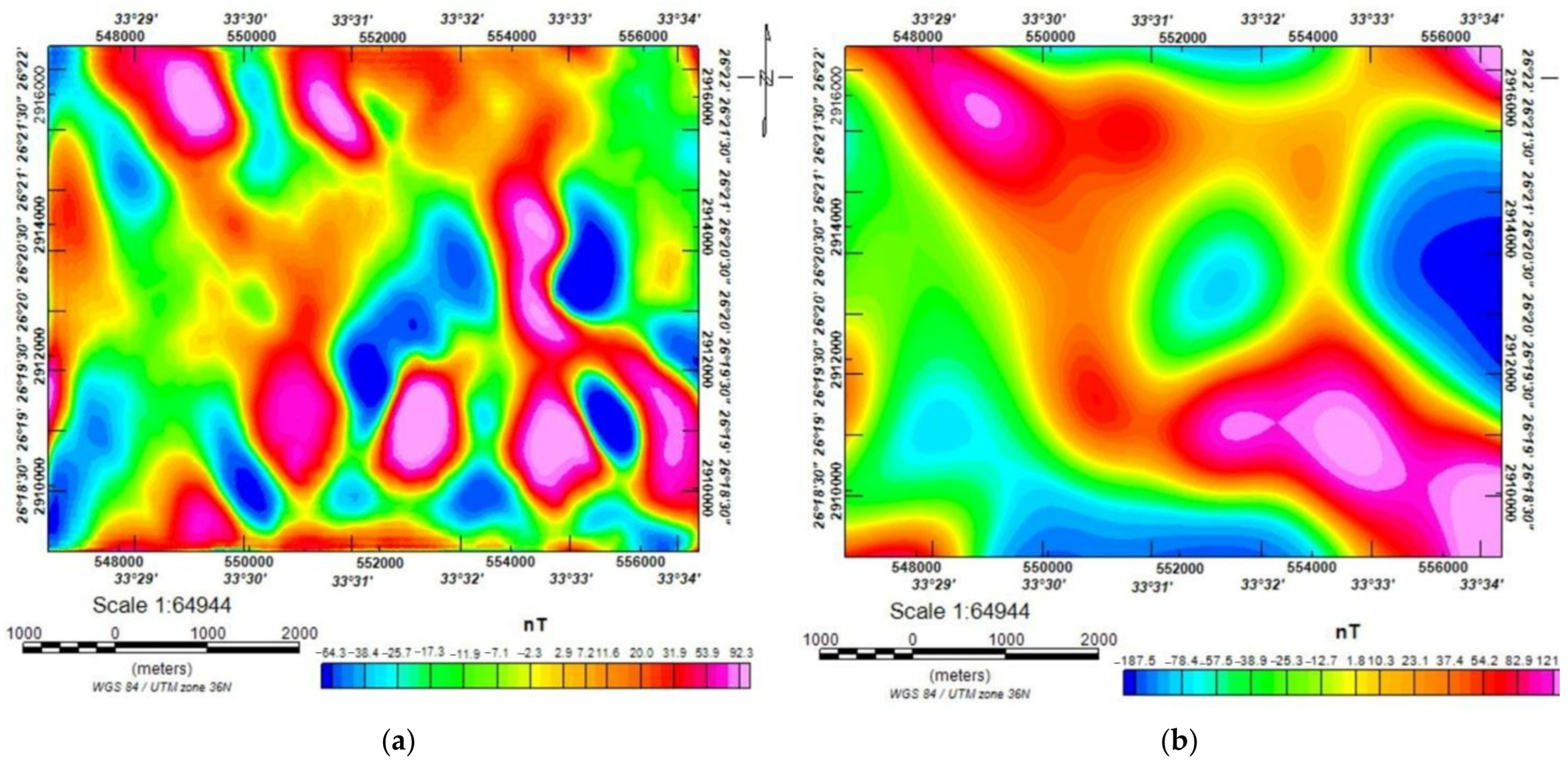
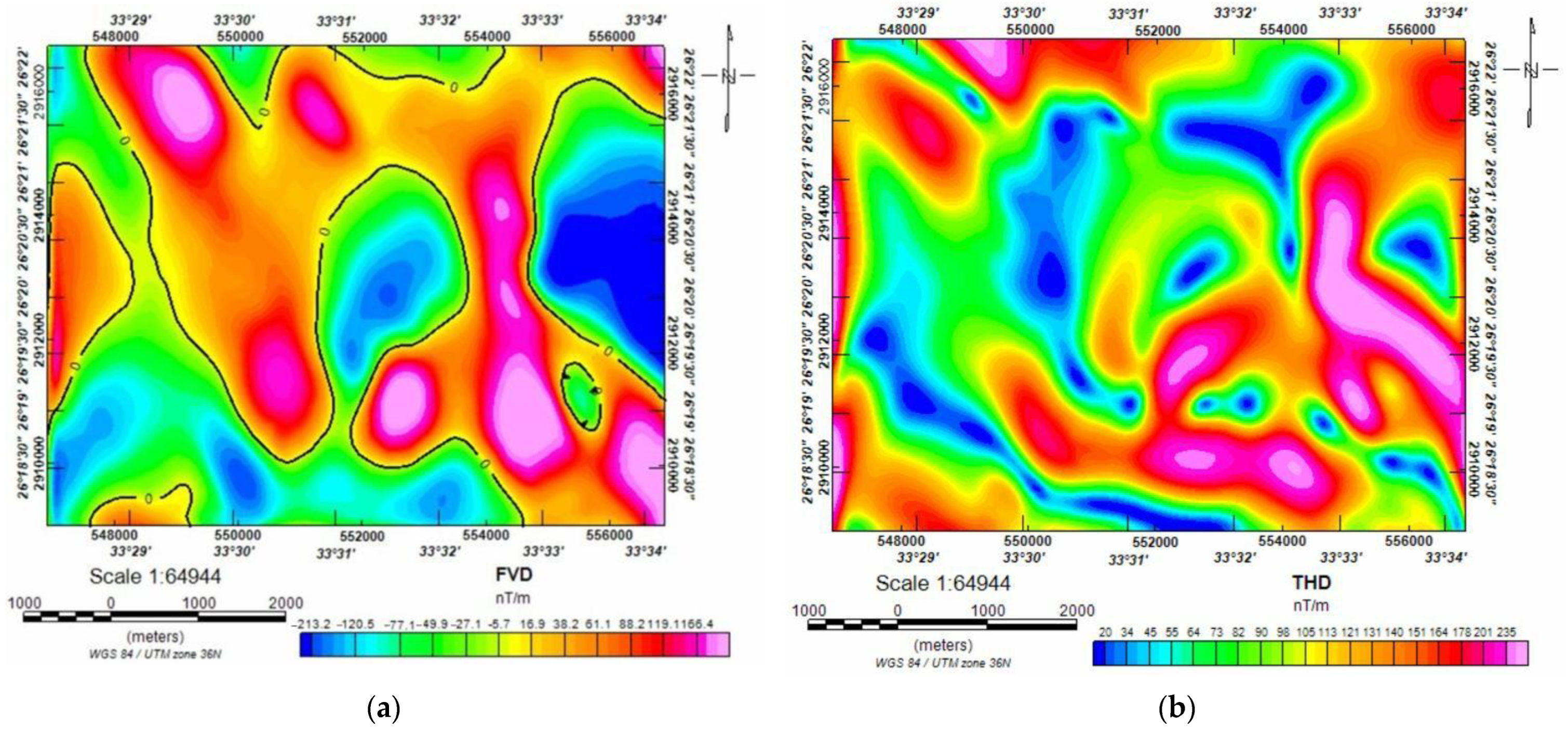
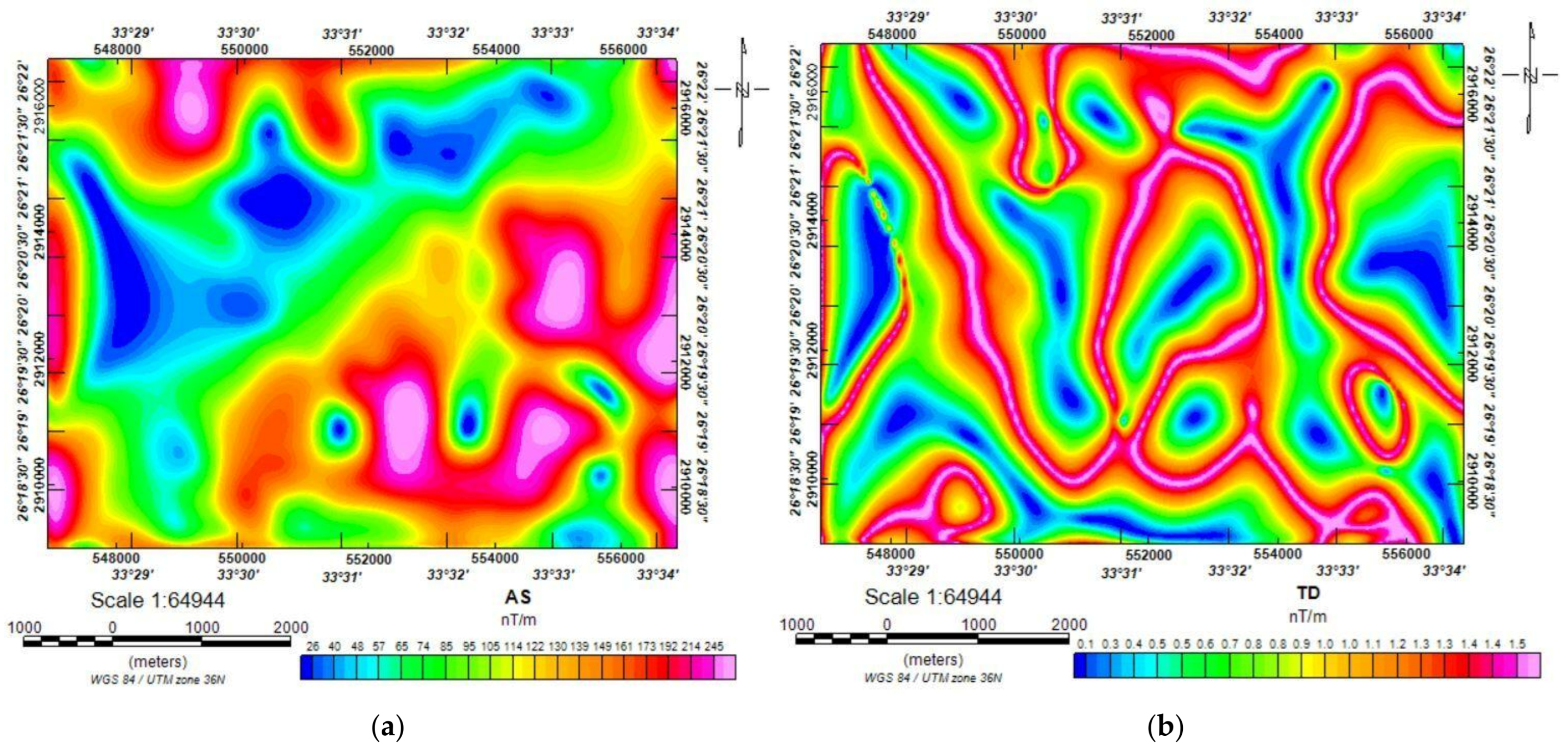
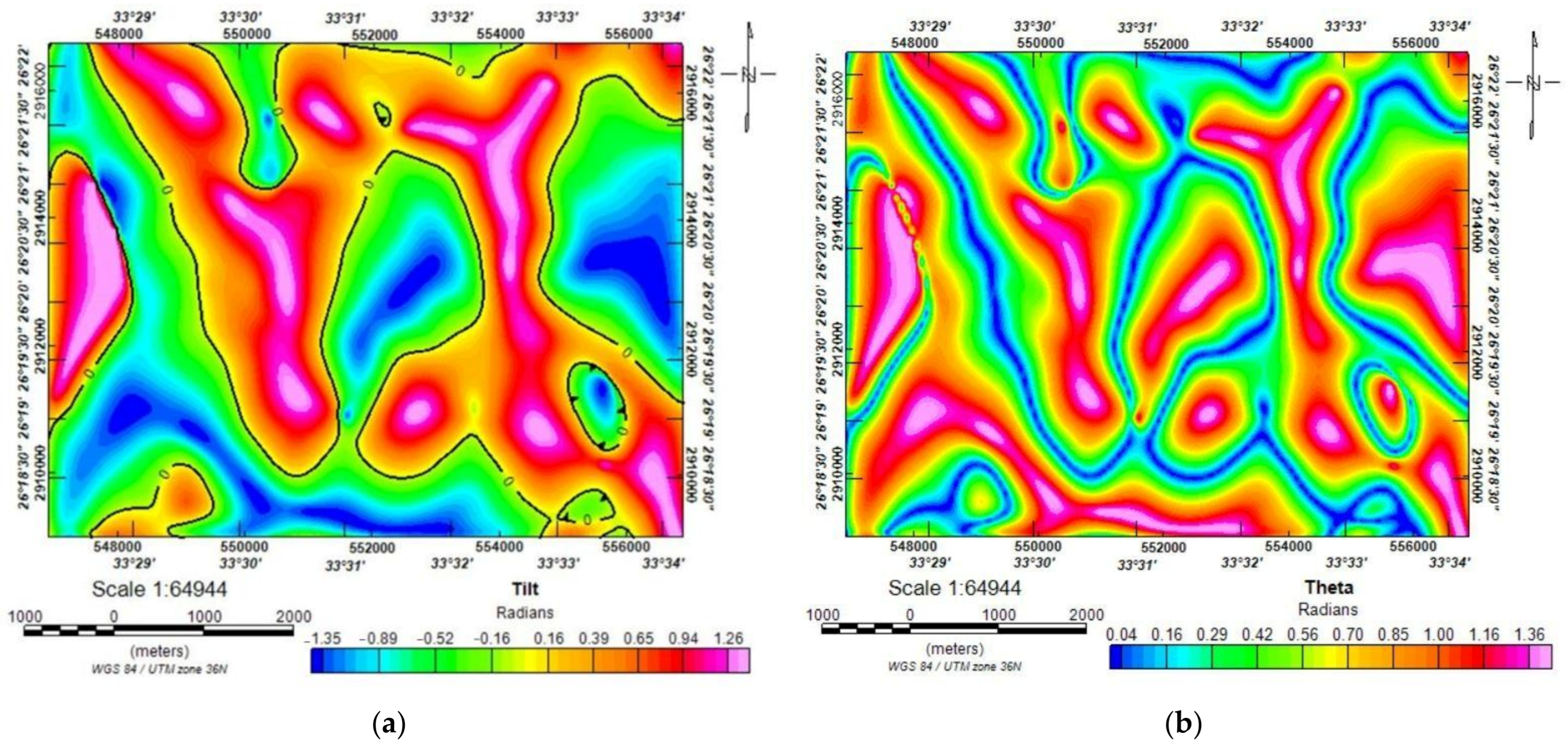
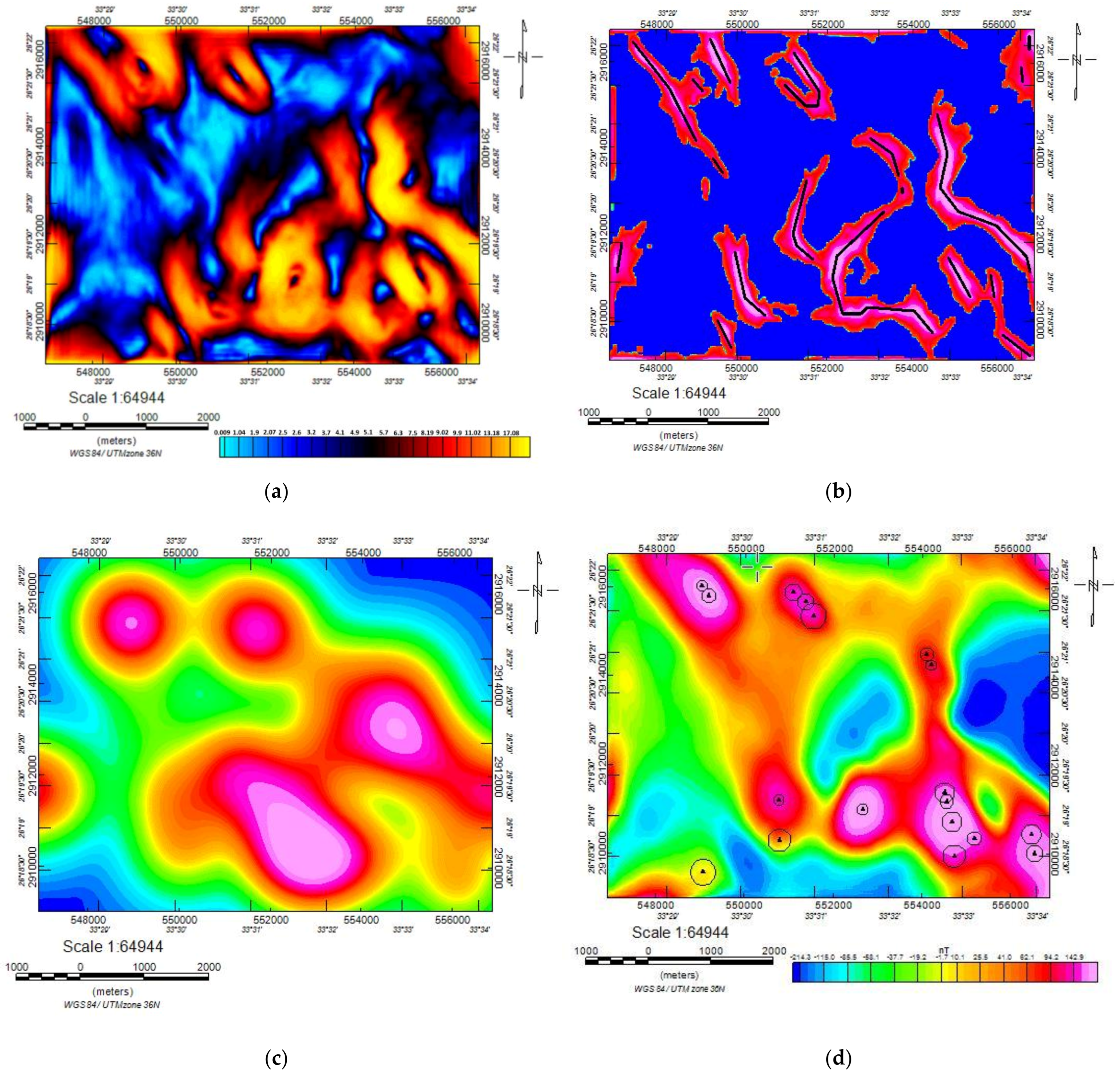

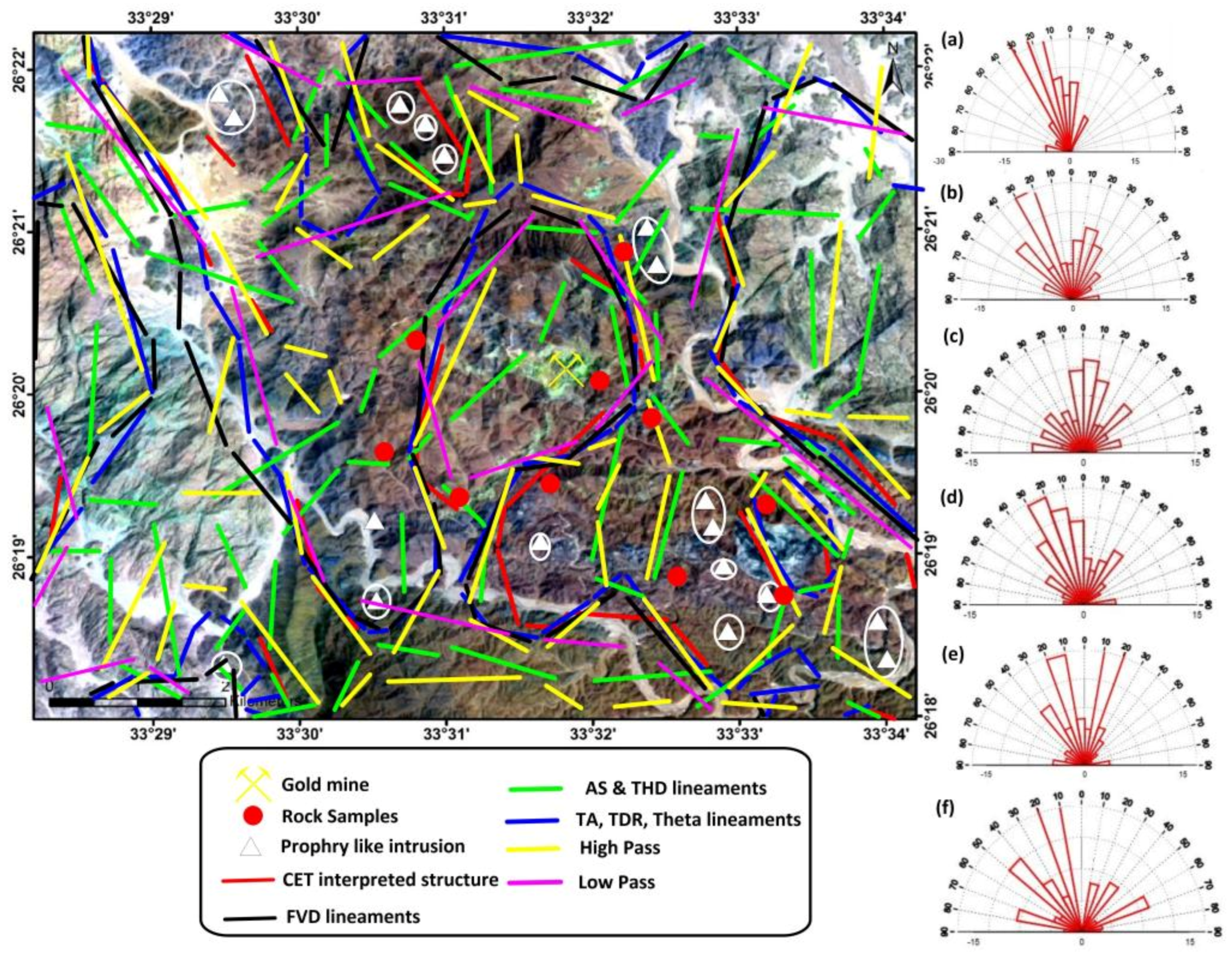
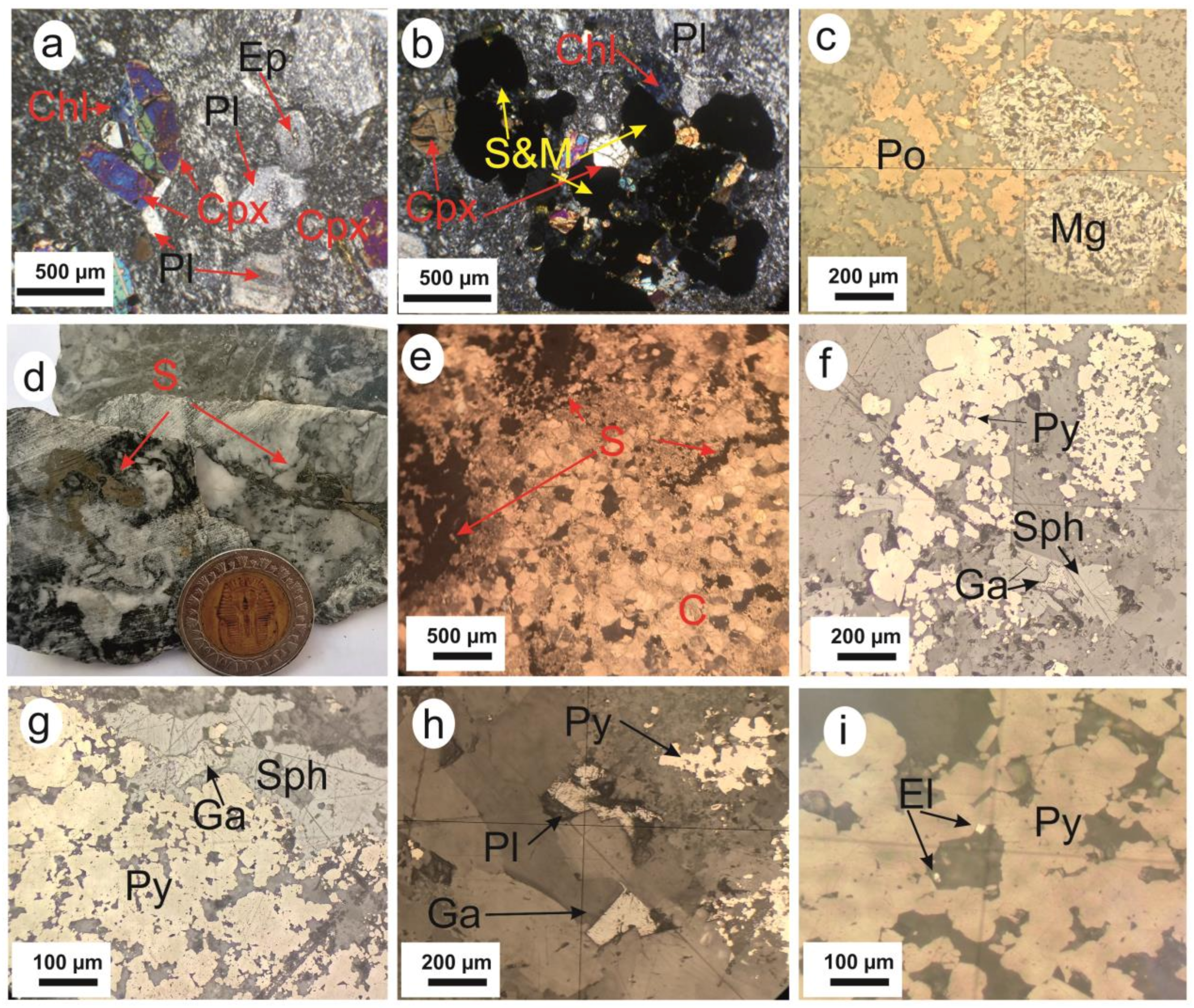
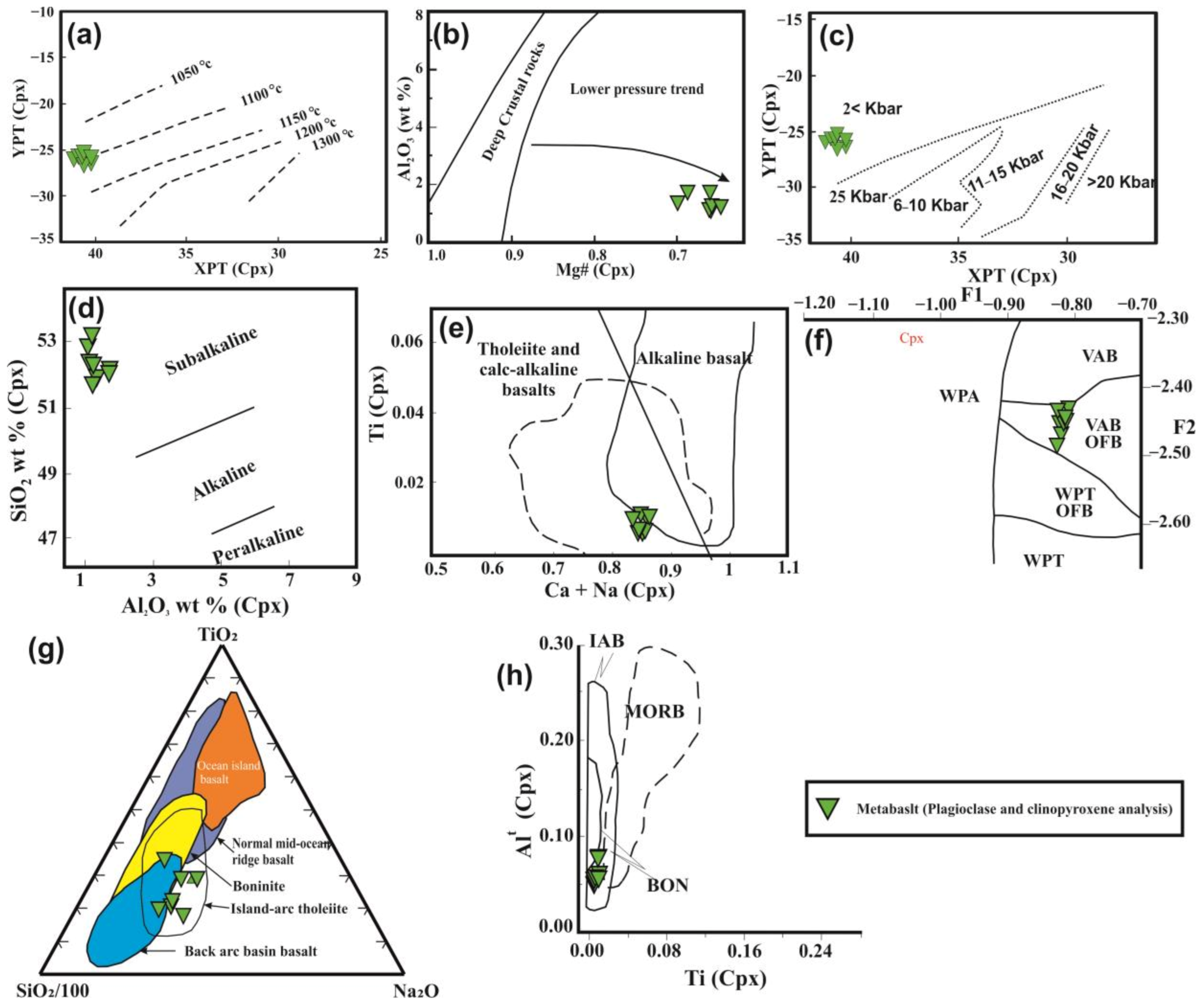
Disclaimer/Publisher’s Note: The statements, opinions and data contained in all publications are solely those of the individual author(s) and contributor(s) and not of MDPI and/or the editor(s). MDPI and/or the editor(s) disclaim responsibility for any injury to people or property resulting from any ideas, methods, instructions or products referred to in the content. |
© 2023 by the authors. Licensee MDPI, Basel, Switzerland. This article is an open access article distributed under the terms and conditions of the Creative Commons Attribution (CC BY) license (https://creativecommons.org/licenses/by/4.0/).
Share and Cite
El-Raouf, A.A.; Doğru, F.; Abdelrahman, K.; Fnais, M.S.; El Manharawy, A.; Amer, O. Using Airborne Geophysical and Geochemical Methods to Map Structures and Their Related Gold Mineralization. Minerals 2023, 13, 237. https://doi.org/10.3390/min13020237
El-Raouf AA, Doğru F, Abdelrahman K, Fnais MS, El Manharawy A, Amer O. Using Airborne Geophysical and Geochemical Methods to Map Structures and Their Related Gold Mineralization. Minerals. 2023; 13(2):237. https://doi.org/10.3390/min13020237
Chicago/Turabian StyleEl-Raouf, Amr Abd, Fikret Doğru, Kamal Abdelrahman, Mohammed S. Fnais, Ahmed El Manharawy, and Omar Amer. 2023. "Using Airborne Geophysical and Geochemical Methods to Map Structures and Their Related Gold Mineralization" Minerals 13, no. 2: 237. https://doi.org/10.3390/min13020237
APA StyleEl-Raouf, A. A., Doğru, F., Abdelrahman, K., Fnais, M. S., El Manharawy, A., & Amer, O. (2023). Using Airborne Geophysical and Geochemical Methods to Map Structures and Their Related Gold Mineralization. Minerals, 13(2), 237. https://doi.org/10.3390/min13020237







